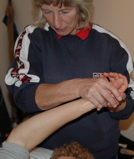
Uncategorised (7)
MY PROFESSIONAL CAREER
Education
I was educated at St. Paul’s Girls’ School, London, and St. Hugh’s College, Oxford University (1968-72), where I had an Open Scholarship to read Modern Languages (Italian and French). In my third year I studied in Aix-en-Provence, Paris, Florence and Venice, on a scholarship awarded by the Cutlers’ Company in London. After graduating, I took up physiotherapy training, and qualified as a Chartered physiotherapist in 1976. I have worked ever since in the field of physical rehabilitation.
Sports injuries
I specialized at first in sports injuries, and worked in my private practice in west London from 1978 until I left the UK, working part-time or full-time according to my other commitments. I worked with top-class sports competitors as well as patients who played sport for health and fun. I attended the 1977 World Student Games, 1978 Commonwealth Games and 1980 Summer and Winter Olympics as a headquarters physiotherapist for the British and English teams. I set up the UK’s first full-time sports clinic within the National Sports Centre at Crystal Palace (1978-82). For several years I was also physiotherapist to the Squash Rackets Association’s junior boys’ squads, honorary physiotherapist to the Amateur Rowing Association and the Women’s Squash Rackets Association, and I also did occasional work for the British Amateur Gymnastics Association. In 1981 I organized physiotherapy cover for the first London Marathon, and in 1984 I worked as physiotherapy consultant for Portsmouth Football Club, not only treating the players, but helping the Club to select a permanent Chartered physiotherapist.

A sports physio's life is not always easy, but it's always interesting! Cartoon by Michael Bartlett
General practice
I was always interested in health problems apart from those related to sport. Rehabilitation techniques can be applied to a great number of challenging problems, including rheumatic conditions, neurological problems, reflex sympathetic dystrophy, glandular fever, and chronic fatigue syndrome, to name a few. Within the team framework, I have treated patients with cancers and eating disorders, helping alleviate the physical effects of their illnesses. Accidents can happen to anyone, and I treat my share of whiplash injuries and back problems caused by accidents or poor posture.
When the war of aggression was unleashed on my native Croatia (1991-95), I became involved in helping patients with war-related injuries and wounds. In 1992 I was sent on a mission by the UNDP (United Nations Development Programme) and UNHCR (United Nations High Commission for Refugees) to assess the needs of war victims in Slovenia and Croatia. Working with the registered charity 'Franka's Fund for Croatia', I organized a variety of projects for the war victims, including the following: amputees and others were brought to the UK for treatment; training courses in the specialized Bobath Method and other types of modern neurological treatments were organized for Croatian physiotherapists, in Zagreb and Krapinske Toplice Rehabilitation Hospital; volunteer practitioners were sent from the UK to work alongside their Croatian counterparts; training in orthopaedic rehabilitation was carried out; specialist rehabilitation equipment was supplied to Croatian institutions, including modern electric therapy couches; international journals and books were donated to Croatian hospitals; lifesaving medicines were also donated.
Charity work in peacetime Croatia
After moving to my Dalmatian homeland in 2004, I set up a registered charity, Eco Hvar, with a view to improving human health, the environment, and animal care. The charity is based on Hvar Island, but operates in a wider context, not only in Croatia, but also internationally. You can read about our work on the Eco Hvar website and our Facebook page.
Teaching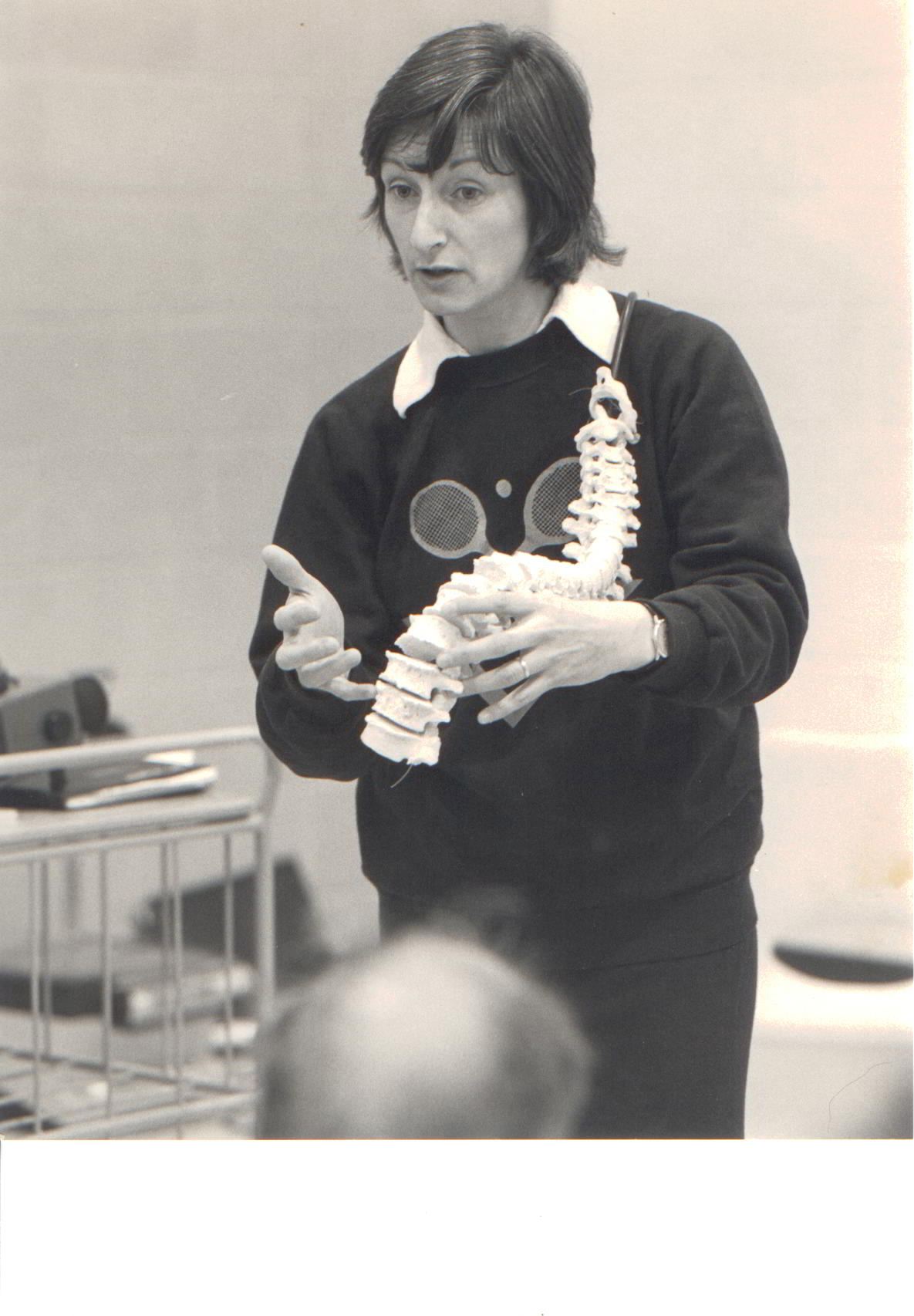 My clinical experiences led into teaching, and in 1986 I was awarded an honorary lectureship to the London Hospital Medical College for the Sports Medicine Diploma Course for Doctors, for which I had lectured since its beginnings in 1981. I was also a member of the committee which set up the post-registration certificate course in sports physiotherapy at Crewe and Alsager. Over many years I have lectured to doctors, physiotherapists and other practitioners, sports coaches, PE teachers, sports participants and patient groups. For instance, I lectured on the Lawn Tennis Association's training programmes for coaches, and gave short courses on massage and injury prevention for physical education students at Avery Hill and North London training colleges. I contributed practical sessions on fitness, injury prevention and relaxation for the Amateur Ballroom Dancing Association (BADA). My teaching work extended to television and radio, and I have done many feature programmes in the UK and abroad about sports injuries, as well as phone-ins offering advice to patients on UK radio stations.
My clinical experiences led into teaching, and in 1986 I was awarded an honorary lectureship to the London Hospital Medical College for the Sports Medicine Diploma Course for Doctors, for which I had lectured since its beginnings in 1981. I was also a member of the committee which set up the post-registration certificate course in sports physiotherapy at Crewe and Alsager. Over many years I have lectured to doctors, physiotherapists and other practitioners, sports coaches, PE teachers, sports participants and patient groups. For instance, I lectured on the Lawn Tennis Association's training programmes for coaches, and gave short courses on massage and injury prevention for physical education students at Avery Hill and North London training colleges. I contributed practical sessions on fitness, injury prevention and relaxation for the Amateur Ballroom Dancing Association (BADA). My teaching work extended to television and radio, and I have done many feature programmes in the UK and abroad about sports injuries, as well as phone-ins offering advice to patients on UK radio stations.
Writings
Teaching led to writing, and I have published many articles for practitioners in professional journals, including “Physiotherapy Treatment for Achilles Tendon Injuries ” ‘Physiotherapy’ 75 (10) 562-572 (1989) and “The Injuries Service at Crystal Palace ” ‘British Journal of Sports Medicine’ 15 (1) 39-43 (1981). For many years I contributed regularly to sports magazines, including ‘Sport and Leisure’ (the magazine of the UK Sports Council), ‘Running’, ‘Squash World’, ‘Squash Player International’, ‘Fitness’, 'Performance Cyclist International’. I was also commissioned to write articles in national publications such as ‘The Times’, ‘The Observer’, ‘Vogue’, and ‘Cosmopolitan’.
I have contributed to other people’s books: ‘The Sports Health Handbook ’ by Norman Harris, John Lovesey and Chris Oram (World’s Work Ltd, 1982); ‘The Pineapple Dance Book ’ by Debbie Moore (Michael Joseph 1983); ‘International Running Guide 1984 ’ edited by Cliff Temple (Tantivy Press 1984); ‘Top Coach: Squash ’ by John Taylor (Pelham Books 1985);‘Sports Injuries and their Treatment ’ edited by B Helal, J King and W Grange (Chapman and Hall 1986); ‘How to shape up your man ’ by Catherine & Neil Mackwood (Sphere Books 1986); ‘The “Running” Guide to keeping fit ’ by Sylvester Stein (Corgi 1986); ‘The Manual of Weight-Training ’ edited by George Kirkley & John Goodbody (Stanley Paul 1986 4th Edition); ‘Improve Your Squash ’ foreword by Ross Norman (Willow Books 1988); ‘Skilegs’ by Tessa Coker (Ski Club of Great Britain 1989); ‘One on One. Your Personal Fitness Trainer ’ by Dave Baptiste (Vermilion 1992); ‘ABC of Sports Medicine ’ edited by G McLatchie, M Harries, J King, C Williams (BMJ Publishing Group 1995).
And I have written my own books:
Sports Injuries, a Self-help Guide, published by John Murray, London (1984). (Also in Portuguese, French, German, Dutch and Spanish, and an American edition 1994)
Know the Game, Sports Injuries, published by A & C Black, London (1989).
International Perspectives in Physical Therapy, Sports Injuries, (editor) published by Churchill Livingstone, Edinburgh (1989).
Strokes and Head Injuries. A Guide for patients, families, friends and carers. Co-authored with Mary Lynch. Published by John Murray (1991).
Children and Sport. Fitness Injuries and Diet, Published by John Murray (1991).
Running. Fitness and Injuries. Published by John Murray (1994).
The Back - Problems and Prevention. Published by John Murray (1996).
The Knee - Problems and Prevention, Published by John Murray (1998).
Sports Injuries, A Self-Help Guide, 2nd edition (completely revised and re-written) Published by Lotus Publishing UK, 2012.
Sports Injuries, a Self-Help Guide, 3rd edition (revised in a new format) Published by Lotus Publishing UK, (30th January 2019).
Always seek professional help. The advice given in this website as articles or in answer to individual queries is not a substitute for visiting your doctor or other practitioner. If in doubt, always be guided by the practitioner treating you. The author cannot be held responsible for readers’ injuries in any circumstances.
The material in this website is copyright. While you may print it out for your own use, none of the website material may be reproduced, in whole or part, in any form, except with the written permission of the author / copyright owner.
Injuries can be categorized into main types according to how they happen: extrinsic, intrinsic, traumatic and overuse or misuse.
Intrinsic injuries are those which happen through overuse or misuse of the body, usually without much warning. They can be sudden and dramatic, such as rupture of the biceps tendon at the shoulder through heavy weightlifting or chopping wood, or a tear of the Achilles tendon in sports like squash and badminton. These injuries can be termed traumatic intrinsic injuries. The activity which causes the injury may be something you do rarely or often. Although they seem to happen out of the blue, there is always an underlying cause, and it’s important for recovery and prevention of re-injury to identify what that is.
Overuse intrinsic injuries come on gradually, and are almost always linked to repetitive or prolonged activity. You might feel pain immediately after the activity at first, and then notice it more and more during the activity. A slight pain may or may not develop to an unbearable level, according to the activity, tissue damage and the way you approach the problem. Examples of overuse intrinsic injuries include stress fractures, tendinitis, peritendinitis and muscle strain. Causative activities usually involve repetitive patterns of movement, as in long-distance running, swimming or rowing. More varied activities can be made dangerously repetitive, if, for instance, you do hours of practice drills or serving practice in tennis. Using the wrong type or size of equipment or inappropriate sports shoes can cause overuse / misuse injuries.
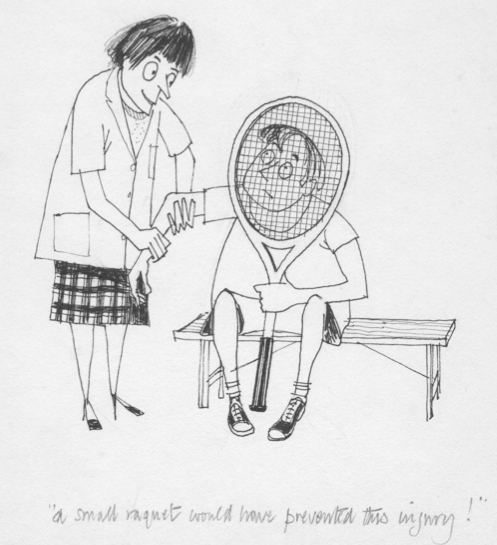
Injuries can cause different types of damage to body tissues, giving rise to a variety of symptoms: pain, bleeding, swelling, skin temperature changes, skin colour changes, and deformation of the injured part.
Pain can be deceptive. As most pain nerve endings are sited close to the body’s surface, a superficial injury can cause a surprising amount of pain, while a deep-seated injury such as cruciate ligament rupture in the centre of the knee can be virtually painless. Where you feel a pain is not necessarily a guide to which tissues, if any, might be damaged. Pain from a damaged tissue can be referred to elsewhere in the body through the nerve pathways, and this can be confusing.
Pain can happen for other reasons apart from overuse or misuse during physical activities. It can arise through different causes, including diseases such as tuberculosis or cancer, viral infections which cause muscle spasm, inflammatory conditions such as rheumatoid arthritis or gout, dietary deficiencies, problems in internal organs, hormonal disturbances, circulatory problems and many others.
You have to describe the pattern of any continuing pain in order to help identify what’s causing it. Keeping a diary of how your pain behaves, is an essential tool for differentiating injury pain from pain due to other less obvious causes. Other symptoms and problems should also be noted. Pain details should set out what kind of pain it is; when it happens; what activities cause it; whether it occurs at rest; whether it occurs according to your position, such as when you sit, stand or lie down; whether it wakes you at night; whether it occurs at night, and if so is that when you turn over, or as you lie still; and whether you can do anything to ease it.
Injuries and pain can turn into a vicious cycle of events, so you need to deal with them as soon as you know you have a problem. The first step is to take note of what your symptoms are, when they occur, and if possible what causes them, or what they are related to. A written record is most useful. If you cannot identify the cause and solve the problem yourself, you need to find the right practitioner too help you. Once you have consulted someone you trust, you must follow the advice given. If in doubt, you can always seek a second opinion, but don't mix treatments, or consult several differing practitioners without reference to each other. Always make sure you have recovered fully before going back to normal activities. Full recovery should not be a matter of guesswork: you and your practitioner should establish exactly what you can and cannot do at each stage of treatment and rehabilitation, and set out tests to lead you progressively to and through the final stage.
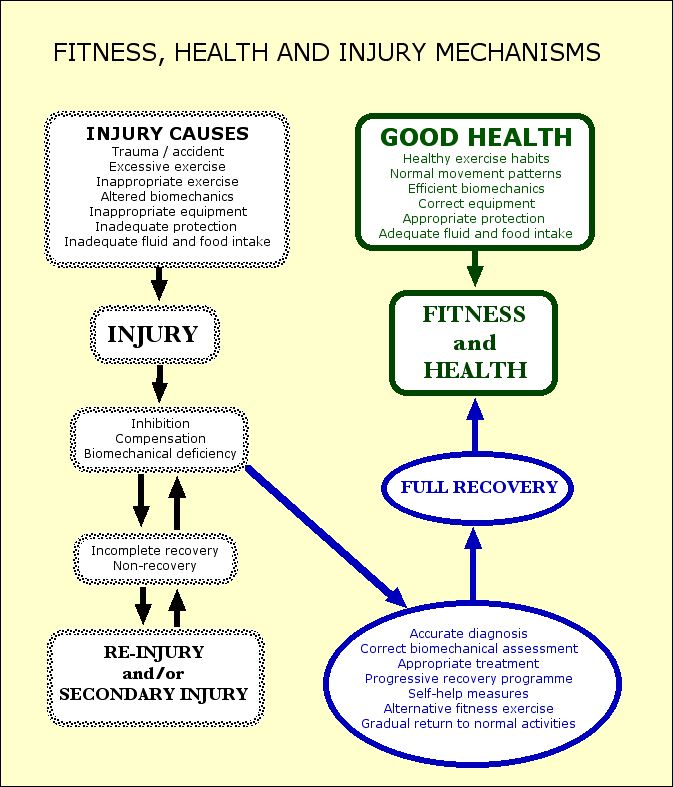
SO, WHAT’S THE PROBLEM?
Why do we eat? Three important reasons are: to sustain life, to have energy for our activities, and to maintain health in our body systems.
Do you make conscious choices about your food and drink? Do you worry about your weight? Do you exclude certain types of food? Are you vegetarian or vegan? Do you take acid-alkaline balance into account in your diet? Do you consider the Glycaemic Index of what you eat? Do you follow dietary systems such as food-combining, Montignac, Atkins, macrobiotic, eating for your blood-type? Do you think about eating healthily? Do you know what a healthy, balanced diet is?
A lot of advice from experts about healthy eating is vague or contradictory, leading to uncertainty about what to eat, when to eat it, how to prepare it, and even how to eat it. “You are what you eat”, the saying goes, and most experts agree about this, but little else.
Dietary inadequacy plays an important part in many different problems. These include hyperactivity and attention deficit disorder in children, and, in all age groups, vitamin and mineral deficiency, obesity, skin blemishes, digestive problems, irritable bowel syndrome (IBS), tooth decay, low mood, low energy, energy fluctuations, chronic fatigue, myalgic encephalomyelitis / encephalopathy, diabetes, osteoporosis, joint problems, many illnesses, candida, anaemia, circulatory problems, and heart disease.
Babies underline the extent of the problems. I have seen all too many babies suffering from extreme, obviously painful cramps after breastfeeding or eating formula food, who are completely transformed if the mother alters her diet to fresh food and no junk, or introduces organic sugar-free baby food.
Overeating and undereating can cause problems, in some cases quickly, more often in the longer term. Many of us have difficulty regulating our intake. Our appetite can mislead us. It can fail when we are under-nourished, or become insatiable when we are over-fed. We often crave the things we should steer clear of. Smell and taste can induce illogical desires for inappropriate foods. Inappropriate eating can make us feel guilty, the more so if other people criticize our intake.
Governments are worried about the impact of poor dietary habits on health, not least because of the cost to public health services. There are reports, initiatives and media campaigns about healthy eating and the importance of exercise, but consumer habits are hard to change. Health messages are not specially effective in persuading people to be discriminating about what they eat and drink, at least not until ill-health forces the issue. The impact of the message is undermined when experts disagree about what is good and bad for us.
When food is plentiful, most people don’t want to think too hard about it, nor to spend much time and effort preparing it, if they feel they have a choice. City life creates a distance between food and its source for most city-dwellers. The tempo doesn’t allow for leisurely eating, never mind cooking. Thousands of city workers spend long hours in the workplace. Proper meals are replaced by a snack or sandwich at their desks, often supplemented (sometimes substituted) by frequent caffeinated or sweetened drinks.
True hunger is a devastating experience, as any survivor of famine or brutal prisoner-of-war camps can testify. Such survivors also demonstrate that the human system can survive terrible deprivations. It’s an unwelcome paradox that in societies where food is plentiful, we can not only eat ourselves “silly”, as the saying goes, but sick as well.
Famine and starvation create simple priorities. Water is vital: a human being dies much more quickly through lack of fluid than lack of food. Food nutrients are complex, but basic needs can be supplied relatively simply, as food aid programmes for people in areas stricken by drought and famine have shown. Also, “superfoods” such as spirulina have been identified, small quantities of which provide large amounts of nutrients beneficial to health.
FOOD PRODUCTION AND SUPPLY
Natural foods
Factors which can have an adverse effect on the nutritional quality of natural foods include the effects of different types of packaging and containers; the coatings on food tins; the time food spends in storage; the distance it travels to reach us; the influence of pesticides and herbicides on soil, plants and fruits; the effect of artificial fertilizers on soil quality; the conditions under which animals, fish and poultry are kept; how they are fed; and whether they receive preventive medical treatments such as antibiotics.
It is surprising how many people ignore the significance of food production methods, never questioning the increasingly controversial ways in which food producers try to improve on nature.
Farming practices have changed through the use of machinery and chemicals, which allow for largescale production and intensive use of land. Farming is a business, and a tough and uncertain one at that, so it is not surprising that so many farmers have taken up the opportunities to reduce labour and increase output through the use of large fields, fertilizers, herbicides and pesticides for crop-growing, and battery farming for chickens and eggs, regardless of the impact on the environment or the welfare of the animals involved.
Pesticides
Most pesticides are known to be harmful to fish, so it is rather surprising that large-scale pesticide use continues despite the evidence of related harm to river and marine life. Smaller scale use is common: some farmers naively believe that spreading herbicide round a field only kills unwanted plants and has no effect on their crops.

Pesticides from intensive farming inevitably leave their traces in the foods, and certain levels are allowed as safe, according to the definitions of current knowledge. The amount of pesticide allowable as a residue on foods is measured in milligrams per kilogram and termed the Maximum Residue Level (MRL), the value of which is set much lower than the Acceptable Daily Intake (ADI), the theoretical amount of a chemical which we can consume every day without harm.
Despite this apparent safeguard, there is cause for concern. In Britain, for instance, the organochlorine insecticide Lindane continued to be widely used even after being placed on the EU Black List of dangerous substances. Showing up regularly in food tests, it was found in record levels above the MRLs in milk during the latter half of 1995, apparently because the summer had been very hot. It is highly toxic to humans and wildlife, and is known to disrupt the human endocrine (glandular) system. It can cause acute poisoning as well as chronic, sometimes fatal illness. It is extremely damaging to the environment, and, being a persistent pesticide, remains active for a long time.
It’s even more worrying that when several pesticide residues are present in foods, their combined effect is not known, as most research on safety levels focuses only on single pesticides. With the increasing evidence that pesticide residues damage the human immune system, it must be wise to consider eating organic food only, and especially to provide organic food for the vulnerable, such as babies, the sick and the old.
The incidence of myalgic encephalomyelitis (M.E.) was known to be relatively high among fruit farmers in the UK in the 1980s.. A dairy farmer once described to me her frustration when her 12-year-old daughter became very ill with M.E., and she and her husband realised they would have to leave their farm or send her away to recover. They had no doubt the illness was linked to the chemicals they had been using on their fields.
Manipulated Food
Artificial flavourings, colourings and preservatives, which in the European Union are identified by “E” numbers, are an important element in producing food for distant markets. Food additives have made it possible to improve taste and visual attractiveness, and to preserve foodstuffs from decay for longer than previously. This is often at the expense of natural health-providing nutrients, some of which have to be replaced artificially to make the food worth eating at all.
Foods which have been refined in some way now form a large part of the average Western diet. Type 2 diabetes is now relatively common in many European countries. Many factors contribute to this, but high use of refined sugar is a major one.
Convenience foods for immediate consumption provide instant snacks or meals for individuals and families, at home, work or in any other context. Even simple natural foods like fruits and vegetables are grown to specification, for uniformity in size and colour. Genetic modification of foodstuffs, linked to pesticides, has aroused public opposition in many countries. Like every other modification of natural processes, the real effects of GM foods on the human system won’t be known for a very long time. If they turn out to be bad, a lot of damage will have been done by the time we know for sure. The already known ill-effects on the environment and wildlife give reason for alarm.
Food on a passport
Quicker transport methods have made it possible to import exotic and out-of-season fresh foodstuffs from other countries to provide greater variety all the year round. Paradoxically, there is often quite a gap between the time local fresh produce is picked and the time it appears on a supermarket’s shelves. People whose only experience is of supermarket fruit and vegetables are usually amazed at the difference in taste if they visit areas or countries which have preserved the tradition of individuals bringing their naturally cultivated produce to market each day. The recently coined expression “food-miles” reflects concern at the impact on the environment of jetting food round the world without a particular need.
FOOD MARKETING
With prosperity, there is an abundance of food, and consumers have a wide choice. A food industry driven by market forces readily caters for factors such as convenience, cheapness and gratification which can motivate food choices. It is an apt reflection of a society driven generally by greed.
Believe that, you’ll believe anything
Food and drink marketing is geared to selling for maximum profit. Advertisements focus on taste and appearance. UK food labelling gives a lot of information, but still falls short of identifying whether a product qualifies as healthy or not. Many people assume that if a product is sold in a food store it must be healthy, or at least it can’t be bad for us.
It’s not surprising that new generations, surrounded by plenty, often don’t know the difference between healthy nutrition and oral gratification. Foods high in fats, sugar and salt seem tastier than natural foods. Drinks loaded with sugar and flavourings are more attractive than plain water. Children of course don’t question what food is, and where it comes from. Some children even believe that chips grow on farms, through confusing the nursery rhyme “old Macdonald’s farm” with the hamburger chain.
Children are exposed to advertising propaganda on television from an unreasonably early age. In the UK, there has been government concern, and restrictions have been placed on advertisements for junk food aimed at children. In 2006 a programme of healthier school meals was introduced. Some parents condemned this as an infringement of personal freedom, and took pride in passing burgers and chips through the school gates to prove their point.
Controlling obesity
Weight control is a primary concern in Western societies, especially as increased obesity and lack of fitness among children is taking its toll in an upsurge of serious adult diseases, especially of the heart. There are many fashionable and not-so-fashionable ways of reducing bodyweight. Surgery to remove body fat is an extreme and usually short-term solution. In recent years, other types of surgery have become available.
Most restrictive reducing diets carry the disadvantages of being short-lived, socially isolating and often energy-reducing. Many reduce bodyweight in the short term, only to lead to an increase over a longer period. People on “slimming” diets are often tempted to skip meals, especially if they find it difficult to control the amount they eat once they start, but this leads to a vicious circle of hunger, overeating and ever-increasing weight gain.
The overweight person who wishes to lose weight may be fighting a veritable army of adverse factors. Internally, there may be excessive appetite, stimulated by overindulging in refined foods heavily laden with sugar or salt from the earliest age, or by the need for “comfort” in times of crisis. Our ability to metabolize and utilize foods can be changed dramatically by hormonal factors, illnesses or changes in body chemistry triggered, for instance, through certain drugs. Externally, there may be constant temptation to eat enticing, filling, non-nutritional foodstuffs, because of advertising, availability, or the example of people around enjoying them at all times of the day.
Balanced information about losing weight and gaining health is sometimes hard to glean among the wealth of fashionable and faddish “slimming diets”. Guilt about being overweight and/or overeating can add a heavy emotional burden which makes rational decisions about the right weight-reducing strategy even more difficult.
Low weight and eating disorders
In Western societies, thin is considered beautiful, especially among women, which has created pressure on young people in particular to aim at the lowest possible bodyweight. This is known to be a factor in the eating disorders anorexia nervosa and bulimia, although of course these potentially serious diseases are usually triggered by a wide range of much more complex causes. Anorexia has a very high mortality rate, so it is essential to recognise it quickly and seek professional treatment.
The myth that slimness in itself means good health and fitness is common, especially among sports participants. It is one of the reasons why anorexia among athletes is often not recognized until it is very far advanced. Many people do sport in order to keep slim while eating as much as they like of tasty but non-nutritional products and drinking excessive amounts of alcohol.
People often imagine that top competitors follow rigorously controlled, healthy diets. In fact many eat the most careless combinations of non-nutritional convenience and “junk” foods, often in defiance of the best advice given them by dieticians and nutritional experts. Looking lean is not the same as being fit, and competitors can wreck their chances of success through faulty diet planning. Poor diet can be one of the reasons why problems more often associated with obesity, such as heart disease, can occur in thin fit-looking people.
Gaining weight, strength and energy is as much of a problem for people who are underweight through illness as reducing fat is for the overweight. In anorexia, there is resistance to eating, because the victim is always convinced that his or her body is grossly bloated, even when in fact it has become skeletal. For the person suffering or recovering from a debilitating illness, such as lung disease or AIDS, the appetite is often impaired, and it can be difficult to ingest enough energy-enhancing foodstuffs without upsetting the digestive system.
Do we need supplements?
Concerns about the denaturing of our foodstuffs have given rise to a booming market in food supplements. The fact that we can no longer rely on our normal foods to provide all the vitamins and minerals we need was borne out a few years ago by a survey reported in the British national press, which showed that some oranges sold in supermarkets contained no vitamin C at all. The survey took place before supermarkets stocked organic fruit and vegetables. The situation, hopefully, has changed with the availability of organic foods, but the possibility that we might need supplements still needs to be taken into account.
It is widely thought that we may need to take antioxidants, especially vitamins C and E but also vitamin A, selenium and zinc, to counteract the effects of oxidation, or free radical damage, which has been linked to many degenerative illnesses, including Alzheimer’s disease, heart disease, certain cancers, diabetes and cataracts. Oil of Evening Primrose is often recommended by doctors and nutritionists to help balance the female hormonal cycle.
If in doubt, it’s best to work out with the help of your doctor or nutritionist what your individual needs are, whether you need supplements, and if so, how to take them. It’s not advisable to go out and buy a whole range of pills to try to cover all eventualities, as some may not be complementary with each other, some you may not need, and some may be difficult for you to absorb. Thinking through the dietary options is also essential, just in case you are tempted to rely on supplements for your essential nutrients in order to eat and drink a “junk” diet. Top sports competitors are surprisingly prone to doing this, rather than taking the trouble to buy and prepare more adequate foodstuffs which would serve their digestive and energy needs better.
Choosing wisely
It’s easy to identify what isn’t good for us. The list has to include refined sugar, refined flour, fatty foods, fried foods, prepared meals, processed products, sweetened products, salted products, trans-fats, preservatives, additives, artificial flavourings, colourings, confectionery, “snack” and “junk” foods, fizzy drinks, caffeine and alcohol.
Practical guidelines for choosing the best eating pattern for yourself include:
* Eat regularly, to suit your energy needs
* Vary your diet
* Choose foods of benefit to health and nutrition
* Include as much variety of locally grown fresh fruits and vegetables as you can
* Grow your own vegetables and herbs
* Take note of how well you digest different foodstuffs:
= Avoid foods which cause bloating or wind
= Avoid foods which cause constipation or diarrhoea
* Take note of adverse reactions:
= Avoid foods which cause symptoms of food intolerance
* Change your eating pattern if you go light-headed between meals
* Alter your diet if your needs change because of lifestyle changes, different exercise patterns, illness, hormonal changes or changes associated with growth or aging
Be flexible, keep informed
Diet is a matter of personal choice. it’s only through education and positive experience that we can learn to make reasoned choices for ourselves and future generations.
However healthy we consider our eating intake and patterns, we should always be prepared to change our diet, if or when our needs change. It is especially important to adjust a child’s diet during the different growth phases. For adults, dietary needs may change through illness or stress, or if there is a change of lifestyle involving more or less exercise or new types of exercise. For females, dietary requirements are likely to vary during pregnancy, while breast-feeding, at the menopause, or even during the phases of the menstrual cycle.
Diet is a very complex subject, and it’s easy to be overwhelmed by the science and the conflicting theories, or to latch on to some simple formula for “ideal” healthy eating and stick with it unquestioningly. The more reasoned approach is to be informed, and to keep an open mind. Be receptive to new information, be flexible, and above all be guided by your own reactions. This is what the expression “gut feeling” really means.
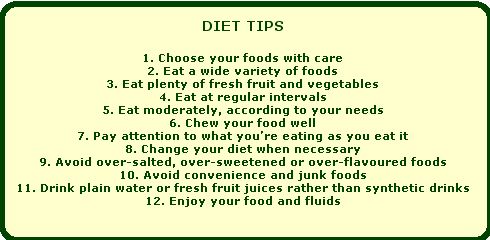
In the developed world, medical practitioners, backed by medical researchers, know a lot about many illnesses and how to cure and prevent them. Vaccination programmes have reduced the incidence of many diseases, while better diet and more hygienic living conditions have given improved resistance to infections. Yet we’re not all glowing with good health. The reasons for this are complex. Many factors (genetic, environmental, dietary or social for example) intertwine in the age-old battle for human health.
Infectious illnesses
Although infectious illnesses can cause epidemics among groups or populations, it is also possible for highly infectious diseases, such as tuberculosis, to affect only a minority of individuals within a group. Rather oddly, illnesses which are not considered particularly infectious, such as glandular fever (caused by the Epstein-Barre virus) can affect many members within a group. Resistance to illness depends on the strength of an individual’s immune system. Within a normal population, those most vulnerable to illnesses and infections are the very young, in whom the immune system has not yet developed properly, and the very old, whose resistance may have been undermined by many different factors. People of any age are prone to illnesses if they have suffered physical hardship and deprivation, especially in war situations or forced labour camps, or mental distress, such as examination pressures, relationship problems or work worries. The more depleted our energy levels, the greater our vulnerability to illness.
Signs and symptoms of illness
The effects of common illnesses include a raised temperature, high pulse rate, high blood pressure, runny nose, sore throat, breathing difficulties, cough, headache, upset stomach, changes in your urine and urine production, night sweats, unusual sweating after only minor activity, or fatigue. Your skin may be affected by rashes or spots. Your tongue can become coated or discoloured. There may be inflammation, redness or other signs affecting the eyes and eyelids. Glands may swell up, especially in the back of the neck or the throat. There may be joint or muscle pains, muscle spasms, strange sensations such as tingling, loss of balance, distorted vision, dizziness, and difficulties or loss of control of the normal functions of passing urine or faeces.
You may be aware of feeling unwell, “under the weather”, “low”, “poorly” or unusually tired. When the immune system is undermined, our energy levels are usually low, but in some cases they can be abnormally high. It can happen that the first sign of illness is a feeling of unlimited energy and a need for action. Once the illness is established, energy levels drop dramatically.
Confusingly, sometimes illnesses occur without making us feel unwell. There may be subtle or misleading symptoms. For instance, you might think your sudden stiff neck was due to sitting in a draught, or sleeping in an awkward position when in fact it is the first sign of a viral-type infection. This is extremely common, and one pattern is for the illness symptoms to come out some days after the neck pain has started. Sometimes the neck pain disappears as symptoms like a sore throat, running nose or cough appear. Normal treatments for neck pain, such as manipulation, usually make no difference in this situation until the illness has passed.
Pain in the middle or upper back region, on one side or the other, can feel just like a muscle strain, yet may be the first sign of pleurisy (inflammation of the lung covering). Pain in the left shoulder region can simulate a joint injury, but might also be the early symptom of a heart attack. Pain in the region of the right shoulder can be linked to stomach problems.
Diagnosis and medical treatment
When you are aware of feeling ill, especially if the symptoms last more than a couple of days, you should refer to your doctor for diagnostic checks as necessary (perhaps X-rays, blood tests or other forms of screening) and appropriate treatment. If you are prescribed medicines, especially antibiotics, you should also rest, preferably in bed. If you have a child who is ill, diagnosis and proper care are essential to avoid the possible serious problems which can occur, for instance if meningitis is not recognized and treated in time.
Doctors and practitioners don’t pretend to know everything, and they can make mistakes. Every patient has the right to question the doctor, to refuse treatment, and to seek further medical opinions. With more information available about most illnesses, especially over the internet, and with increasing openness by medical practitioners, patients can make well informed decisions about how to deal with health problems, if they so wish.
In order to get the best from the doctor or specialist, the patient in turn has to be open, and provide full relevant details of what the problem is, and any other opinions or treatments that might have been given. If you are accepting treatment from a practitioner, you must be guided by that practitioner, and seek advice before trying any self-help measures.
Rest
Illness is a signal that it is time to give the body a rest. All too often, we try to ignore or suppress the symptoms and carry on as normal. These are mistakes which can lead to prolonged ill-health, recurrences of illnesses, or long-term debilitating conditions like chronic fatigue syndrome and myalgic encephalomyelitis. In the worst of cases, doing strenuous work or exercise with an infection can damage the heart and even cause death. If you are physically active or play strenuous sports while you are ill, you can easily injure yourself, as your joints and soft tissues are more vulnerable to over-strain when your immune system is undermined.
To cure most illnesses it is vital is to rest completely, and drink plenty of water. A day or two in bed at the start of any illness can significantly reduce its severity and speed up the recovery process. If total bed-rest is impractical, the next best alternative is to lie down at every possible interval during the day, even if only for five or ten minutes at a time. If you allow your body and mind respite, you give the natural defences of the immune system a chance to come into action, to fight off the infection and then replenish the energy systems.
If you are confined to bed for more than a few days, you will need to do anything you can to help your circulation and to avoid pressure sores. Circling the feet, tensing and relaxing the leg muscles, lifting and lowering your arms, clenching and relaxing your hands, and changing position at frequent intervals are all part of this.
Breathing exercises
Make sure your doctor agrees before trying to use breathing exercises during illness.
Breath control and deep breathing exercises help to calm your pulse rate and blood pressure, clear the airways in the lungs, maintain lung elasticity and keep the lungs functioning as fully as possible. They are also useful for relaxation, and can help you to sleep better during your illness. They are especially important if you are confined to bed for an extended period.
A productive cough is a chesty cough where you can hear and feel excess sputum or phlegm in the lungs, often with a distinctive rattling sound. When you have a chest infection, breathing exercises can help clear infected fluids from the lungs. A simple way of doing this is to lie on one side, and take 3-4 deep breaths, making sure that your lower ribs expand as much as possible. Have a rest, then repeat the deep breathing 2-3 times. Sit up and cough 2-3 times, and if possible spit out any sputum or phlegm into a tissue (or a disposable pot if there is a lot of it).
Note the colour of your sputum, which might be clear, white, yellow, brownish, green, and may contain blood stains. This is information your doctor needs. You may be asked to produce a small specimen of the sputum for laboratory analysis.
You can repeat the process of deep breathing and coughing a few times on one side, and then turn over on to the other side to clear the other lung. If one side is worse than the other, do more exercises for that side. Always pace yourself carefully. If you become light-headed or over-tired, rest, and don’t do any more breathing exercises for a couple of hours. If you don’t have any adverse reactions, you can usually go through these exercises about every hour.
Try to keep the cough controlled: if you cough too hard without being able to breathe in between coughs, you may drive the sputum deeper down into the lungs instead of bringing it up. A really bad hacking cough which you can’t control can cause fainting (technically known as cough syncope) by momentarily blocking the airways and cutting off the brain’s oxygen supply.
To help loosen thicker phlegm, you can use steam inhalations. Put boiled water in a heatproof bowl on a table in front of you. Place a towel over your head and lean over the bowl, so that the steam enters your nostrils as you breathe. Then do a few deep breaths at a time. You can do this for just a few minutes or as long as the steam lasts, if you are comfortable. The inhalations can be repeated as necessary.
Gargling
For a sore throat or irritating dry cough, gargling can help relieve the symptoms (unless your doctor specifically advises against it for any reason). You can gargle with many different substances. One natural remedy that is often recommended is tea tree oil: you put one or two drops in a tumbler of warm water, gargle so that the fluid bathes your whole throat, and then spit the fluid out, repeating the process until you have emptied the tumbler.
Nutrition
In some illnesses, eating is difficult if not impossible, either because of a physical block like a bad sore throat, or because of loss of appetite. If possible, you should try to take in nourishment in the form of liquid foods, such as soups or nutrient drinks. Fresh fruit and vegetables are extremely important. It is often recommended to boost your intake of vitamins and minerals, especially vitamin C, by taking supplements. It is also important to avoid substances which undermine the immune system, especially irritants like coffee, black tea, fizzy drinks, and alcohol. In cases of severe weight loss due to illness, a nutritionist may be asked to help.
Don’t spread your illness around
Most common illnesses are infectious to some degree. None of us likes to be infected. So it’s common sense and courtesy to avoid spreading illnesses around, whether minor colds and coughs or more major infections like lung disease or HIV. If you are coughing and sneezing, stay at home. Don’t travel on crowded public transport or go to school or the office where other people can be infected with your germs. Dispose of used tissues carefully, or wash any dirty handkerchiefs as quickly as possible, making sure others don’t handle them. Always wash your hands, especially after wiping or blowing your nose, before touching things that others have to handle, and especially if you have to prepare food for other people.
Recover fully
It is vitally important to recover as fully as possible from any illness. Feeling better is not necessarily the same as being cured and back to full health. Sometimes there is a feeling of boosted energy and a kind of euphoria in the aftermath of an illness. Unfortunately, this often happens before the illness is quite over, but the sense of relief as the worst of the symptoms disappear can tempt us to celebrate returning to normal life with a burst of activity, such as fulfilling a heavy schedule at work, cleaning and polishing, rearranging the furniture, digging the garden, going for a run, doing an aerobics class or playing a hard game of squash. Relapse usually follows.
The longer an infection lasts, the worse its effects. As the immune system becomes more and more undermined, new infections can take hold more easily, increasing the risk of a more serious illness. This is a common pattern leading up to potentially longer-term debilitating illnesses including glandular fever and myalgic encephalomyelitis / encephalopathy (ME).
Check your pulse
A raised temperature is a sure sign of illness or infection, and should be taken as a warning to avoid strenuous activities and sports which might damage the heart. Another warning sign is a raised pulse. Your basal pulse rate is your pulse count first thing in the morning, before you get up and get going on the day’s activities. Your pulse rate varies for all kinds of reasons, including stress, alcohol, caffeine and excitement, and if these have been present the night before, your basal pulse may be affected, without it meaning that you are ill. However, if your basal pulse is up by ten beats or more from normal, and if you are feeling low and over-tired, or you have early symptoms of an infection, you should not over-tax yourself physically until your basal pulse is back to normal and you feel well.
The basal pulse is a good guideline when you are recovering from lingering illnesses like glandular fever. It is essential for sports players who are trying to recover fitness as well as health. You should record your basal pulse, activities and progress in a diary, so that you have a clear idea of how you are getting on, and what causes any setbacks you may experience.
It helps if you know what your basal pulse is when you are healthy. Even if you only start checking it when you are ill or recovering, it can help you assess your progress, as the basal pulse will go down gradually as you get better.
Avoid illnesses
It’s not always possible to avoid getting ill, especially if you live and work in a city where you are unavoidably in close contact with large numbers of people. In all circumstances, the immune system is the key to avoiding illnesses. It will be at its strongest if you eat a healthy diet, including plenty of (preferably organic) fresh fruit and vegetables, and minimizing or excluding caffeine, alcohol, junk foods, refined flour and refined sugar. Plenty of plain water is a basic requirement for health. There are numerous herbs and herbal remedies to help strengthen the immune system. Many people choose to boost the immune system with vitamin and mineral supplements. If in doubt, always seek professional advice from your doctor, nutritionist or other practitioner.
Good hygiene practices are essential too. Many germs are transmitted by touch, so it is sensible to wash your hands before eating or preparing food, and even before touching your face, mouth and eyes.
Environmental pollution plays a part in undermining the immune system. In heavily polluted cities, it is now common practice for cyclists to use face masks. At the very least, you should avoid walking, running or cycling along busy roads with heavy traffic, if at all possible.
Stress, tiredness and negative emotions such as depression and anger all make us more vulnerable to infections, so avoidance of these is a worthwhile, if often difficult goal. When you are over-tired and stressed, it’s hard to maintain the normal pattern of your activities. Trying to keep going makes you more and more tired. The more tired you are, the more difficult it is for your immune system to build up enough strength to fight off infections. Conserving energy and pacing yourself are important for everyone, but most especially for those who suffer from an underlying condition like multiple sclerosis, which risks getting worse if you over-tax your energies.
Building in rest and relaxation periods to the normal day, even for as little as ten minutes at a time, can be invaluable for allowing the body systems to regain strength and vitality, and therefore resistance to illness and disease.
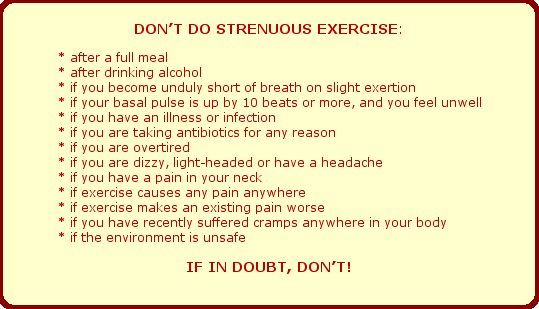
In this section, basic exercises are described in detail. They are listed according to the part of the body they relate to most directly, although many exercises are good for more than one joint or a single section of the body. The central part of your body is the key to how you move and hold yourself. Good balance between all the component parts - the pelvis, stomach area, low back, upper back, chest and shoulder girdle - is essential for all activities and for avoiding pain, especially in the back. Balanced trunk exercises are the key to avoiding back problems or recovering from back pain. Although you may need to focus on a particular part of your body because of injury or imbalance, it is always important to do exercises for the rest of the body as well, and especially for the central area, the trunk.
You can learn how to do the exercises properly, and what each one is good for. Instructions on the pattern of movement, breathing pattern and appropriate speed are given with each exercise, as well as warnings on how to recognise when you should not do a particular movement. For maximum benefit, each exercise should be done very precisely, with attention to the details of the movement. Therefore, they should be done slowly at first, although some are also suitable for aerobic training, and can be done at speed once you have mastered the correct technique of the movement.
For healthy joints, you need to maintain full mobility in each joint, combined with stability. Excessive loading or jarring should be avoided. Stability and good function in your joints depend on muscle efficiency and nerve-muscle co-ordination. Muscle conditioning exercises include strengthening and stretching techniques. Strengthening can be dynamic, involving a movement or movement pattern, or static, where a contraction is held for a few seconds and then relaxed completely. Dynamic exercises which aim to improve muscle condition and strength are usually done against a resistance, which can be bodyweight, a pulley or spring resistance, a weight, dumb-bell or weights bar, or a weight training resistance machine. Resistance exercise generally involves two types of muscle action, concentric and eccentric. In concentric action, a muscle group shortens to perform an action against gravity or a resistance, whereas in an eccentric contraction the muscle group lengthens out to control a movement which would otherwise happen under the influence of gravity or a load.
These exercises are suitable for rehabilitation following injuries, and for general body conditioning. They are good for your muscles, joints, nerve-muscle co-ordination, circulation and balance. To create body balance, you need to select a variety of exercises covering the various parts of the body. In the normal way, the exercises you find most difficult are the ones you need most.
The exercises are safe to do in most situations. Do pay attention to the safety instructions. They may not be suitable for people suffering from neurological problems, for instance after a stroke or head injury: rehabilitation for neurological impairment requires carefully directed patterns of movement, until recovery is well advanced. Patients suffering from neurological conditions of any kind should only do physical exercise under the guidance of a specialist neurological physiotherapist, or other appropriate practitioner.
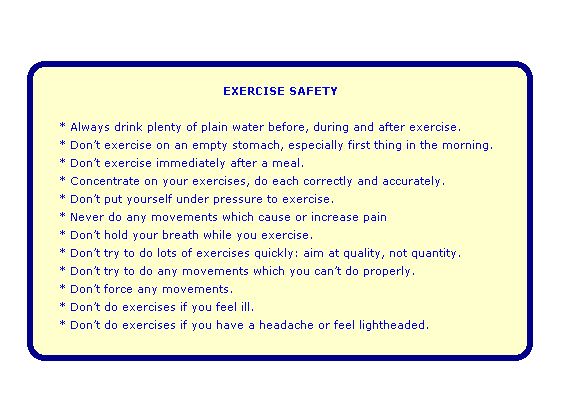
General risks in sports:
* Overplaying
* Overtraining, overdoing physical activities
* Lack of overall fitness
* Poor body balance
* Inefficient technique
* Inadequate or inappropriate equipment, clothing or shoes
* Failure to use appropriate protection, such as shin guards in football, mouthguards for high-risk contact sports like hockey, rugby, and boxing, knee and elbow padding for sports like skateboarding, and helmets for sports like American football and cycling.
* Playing in a dangerous environment (slippery court, icy or rutted terrain, protrusions from surrounding walls or fencing)
* Inadequate diet or intake of plain water
* Playing despite illness or injury
* Failure to recover fully from previous illness or injury before re-starting sport
* Playing despite excessive fatigue and stress
General guidelines for injury prevention:
* Get fit for your sport, don’t try to use your sport for fitness training
* Do protective general flexibility and strengthening exercises for body balance
* Build up your non-dominant side through exercises or simulated skill practice if your sport is heavily one-sided, like fencing, racket sports and archery
* Choose equipment appropriate to your skill and physical levels
* Wear suitable clothing for your sport
* Choose appropriate, well-fitting shoes
* Use protective equipment, clothing and guards
* Hone your technique according to your individual capacities
* Avoid over-playing and over-training
* Allow rest days within your physical exercise programme
* Do not do physical exercise if you have a raised temperature or early-morning pulse rate and feel unwell
* Do not do physical exercise if you are taking antibiotics for any reason
* If you are injured, avoid any physical activity which causes or increases your pain and other symptoms
* Always recover fully from any illness or injury before exercising again
* Build up your physical activities in gradual easy stages
* Avoid doing repetitive training on consecutive days, at least at first
